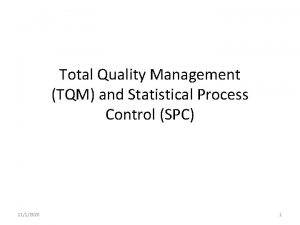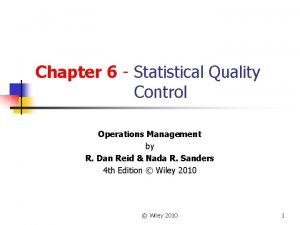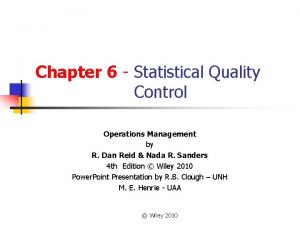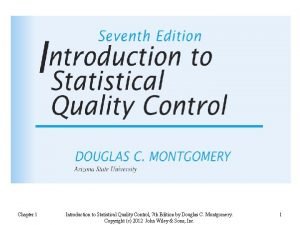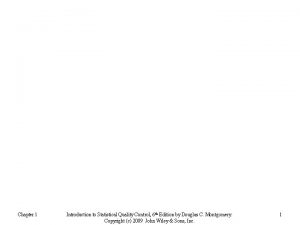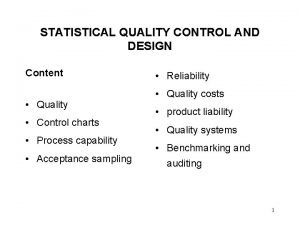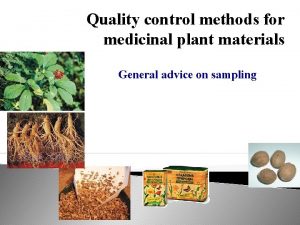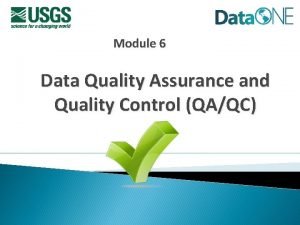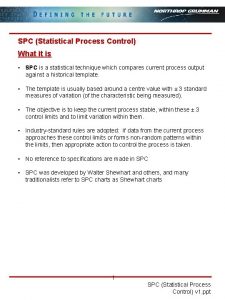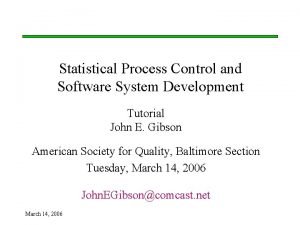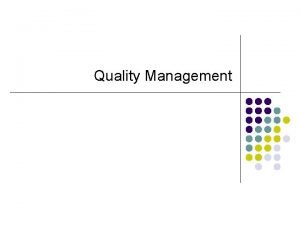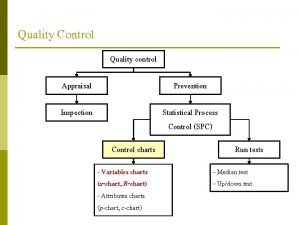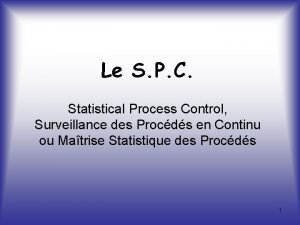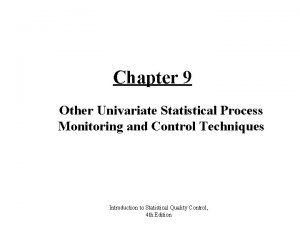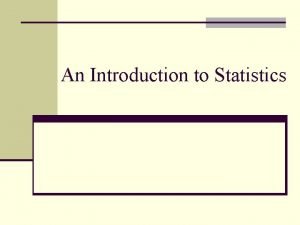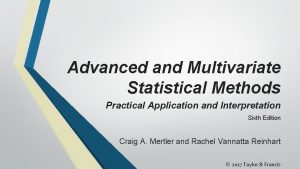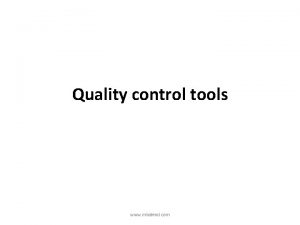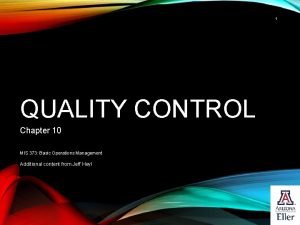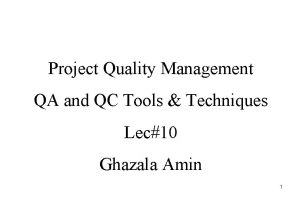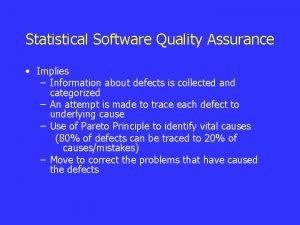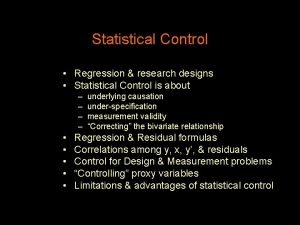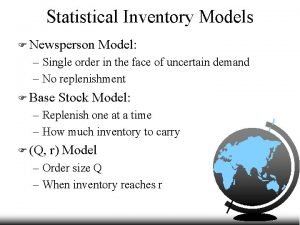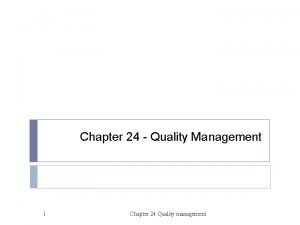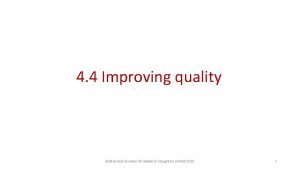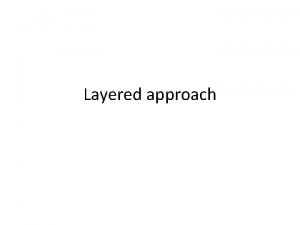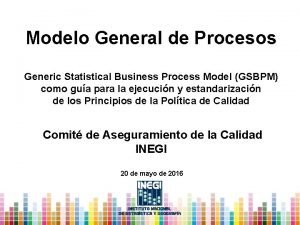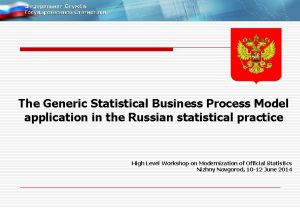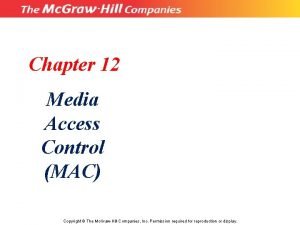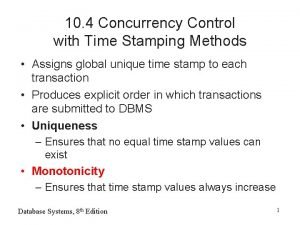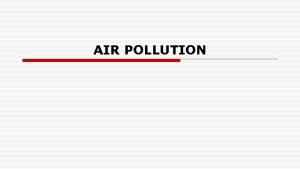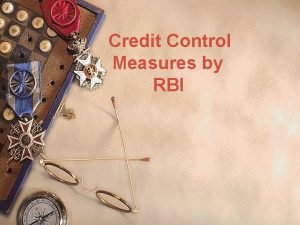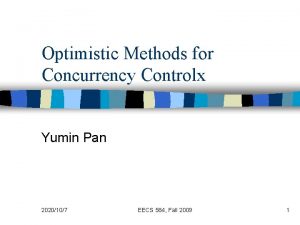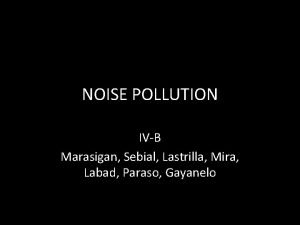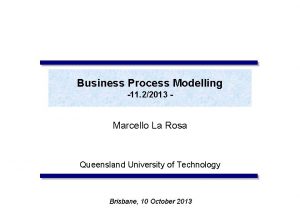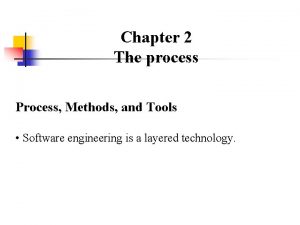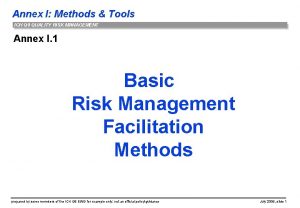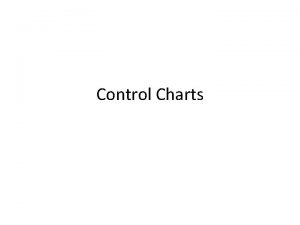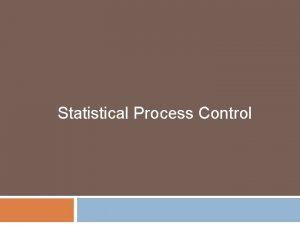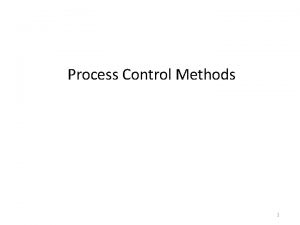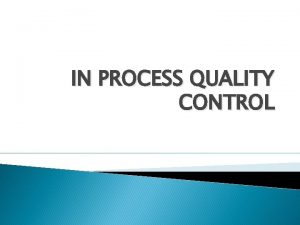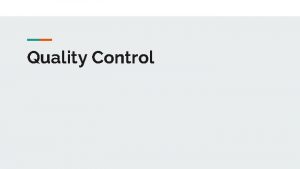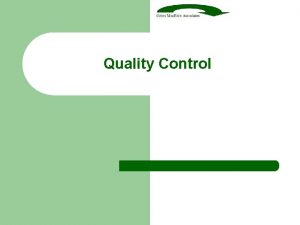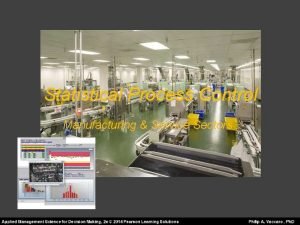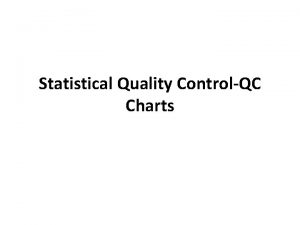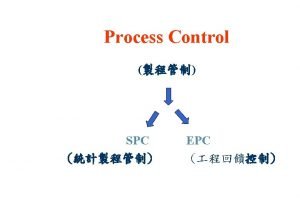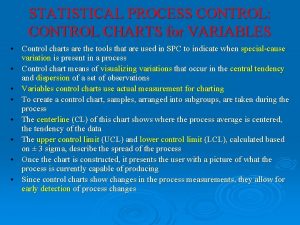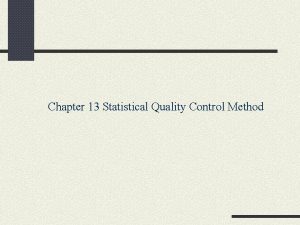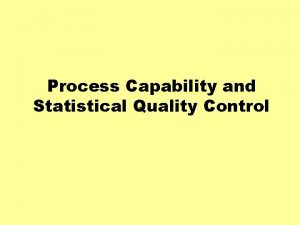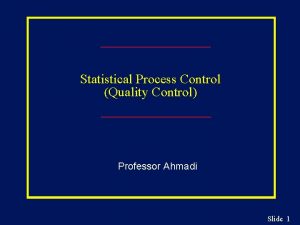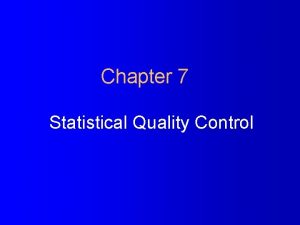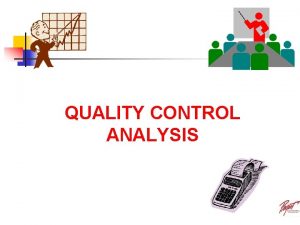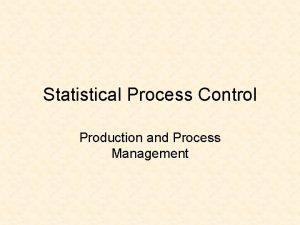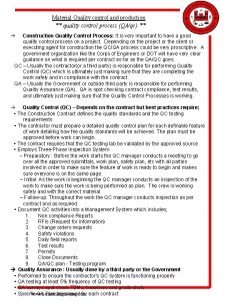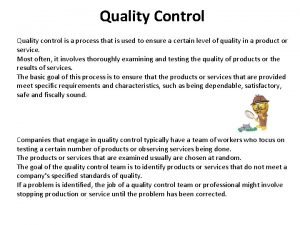Quality Management Statistical Quality Control Methods Statistical Process


































































- Slides: 66

Quality Management

Statistical Quality Control Methods Statistical Process Control Acceptance Sampling Attributes Variables Attributes Type of Data Variables

Statistical Quality Control Methods Attribute Data: data which count items, such as the number of defective items on a sample Variable Data: data which measure a particular product characteristic such as length or weight

Statistical Quality Control Methods Sampling Error Sample results are not representative of the actual population or process The population or process is actually The sample says that the population or process is Customer’s risk Good or in control Bad or out of control Good or in control In agreement or Type II error Bad or out of control or Type I error In agreement Prducer’s risk

Acceptance Sampling Designing a Sampling Plan for Attribute Costs to justify inspection Full or 100% inspection or not? Cost to Inspect Cost incurred by passing a reject

Acceptance Sampling Purpose of Sampling Plan • Find its quality • Ensure that the quality is what it is supposed to be

Acceptance Sampling Designing a Sampling Plan for Attribute n: Number of units in the sample depended on the lot size c: the acceptance number AQL (acceptable quality level): maximum percentage of defects that a company is willing to accept LTPD (lot tolerance percent defective): minimum percentage of defects that a company is willing to reject : producer’s risk : consumer’s risk

Acceptance Sampling Designing a Sampling Plan for Attribute =0. 05 =0. 10 c LTPD/AQL n AQL 0 1 2 3 4 5 6 7 8 9 44. 890 10. 946 6. 509 4. 890 4. 057 3. 549 3. 206 2. 957 2. 768 2. 618 0. 052 0. 355 0. 818 1. 366 1. 970 2. 613 3. 286 3. 981 4. 695 5. 426 MIL-STD-105 E

Acceptance Sampling -Example AQL=2% =0. 05 =0. 10 LTPD=8%

Operating Characteristic Curve

Operating Characteristic Curve p np P(r c) 1% 0. 99 0. 97 2% 1. 98 0. 95 …

Acceptance Sampling Determine a Sampling Plan for Variables Control Limit: Points on an acceptance sampling chart that distinguish the accept and reject regions. Also, points on a process control chart that distinguish between a process being in and out of control. Sample size

Acceptance Sampling l Example ABC Electronics Company buys a 50 -ohm resistor from an outside Vendor. From historical data, the standarddeviation for the resistor is 3 ohms. Determine the appropriate control limits if we use a sample Size of n=100 and we want to be 95% confident that the sample Results are truly representative of the total population.

Acceptance Sampling Determine a Sampling Plan for Variables

Acceptance Sampling l Example Continuing with the resistor problem, we can tolerate some variation in the number of ohms in each resistor. However, if the number of ohms falls below 49, then we would have a serious problem in our electrical circuit. What is the probability of us accepting a lot when the average resistance is 49 ohms or less.

Acceptance Sampling LCL

Acceptance Sampling l Example 8. 53%

Statistical Process Control Statistical process control (SPC) Statistical method for determining whether a particular process is in or out of control. Central Limit Theorem

Statistical Process Control

Statistical Process Control

Statistical Process Control SPC Using Attribute Measurement Attribute data are data that are counted, such as good or bad units produced by a machine. Samples defects Sample size=6 defects=2

Statistical Process Control SPC Using Attribute Measurement Center line = = Long-run average percent defective Standard deviation of sample = Note: x~Bernoulli distribution

Statistical Process Control Variable Measurements Using X and R Charts An X chart tracks the changes in the means of samples by plotting the means that were taken from a process. An R chart tracks the changes in the variability by plotting the range within each sample.

Statistical Process Control Notations: m = total number of samples n = total number of items in the sample Rj = difference between the highest and lowest values in sample j

Statistical Process Control Variable Measurements Using X and R Charts Setup Control Chart: 1. 2. At least 25 samples Setup control limits Control limits for Upper control limit for Lower control limit for

Statistical Process Control n A 2 2 3 4 5 6 7 8 9 10 11 12 13 1. 88 1. 02 0. 73 0. 58 0. 42 0. 37 0. 34 0. 31 0. 29 0. 27 0. 25 D 3 D 4 n A 2 D 3 D 4 0 0 0. 08 0. 14 0. 18 0. 22 0. 26 0. 28 0. 31 3. 27 2. 57 2. 28 2. 11 2. 00 1. 92 1. 86 1. 82 1. 78 1. 74 1. 72 1. 69 14 15 16 17 18 19 20 0. 24 0. 22 0. 21 0. 20 0. 19 0. 18 0. 33 0. 35 0. 36 0. 38 0. 39 0. 40 0. 41 1. 67 1. 65 1. 64 1. 62 1. 61 1. 60 1. 59

Statistical Process Control

Process Capability

Process Capability Ratio The larger the ratio, the greater the potential for producing parts within tolerance from the specified process.

Process Capability Index To determine whether the process mean is closer to the upper specification limit, or the lower specification limit.

Quality Certification l ISO 9000 l l Set of international standards on quality management and quality assurance, critical to international business ISO 14000 l A set of international standards for assessing a company’s environmental performance

Total Quality Management l A philosophy that involves everyone in an organization in a continual effort to improve quality and achieve customer satisfaction.

The TQM Approach 1. 2. 3. 4. 5. Find out what the customer wants Design a product or service that meets or exceeds customer wants Design processes that facilitates doing the job right the first time Keep track of results Extend these concepts to suppliers

Elements of TQM l l l l l Continual improvement Competitive benchmarking Employee empowerment Team approach Decisions based on facts Knowledge of tools Supplier quality Champion Quality at the source Suppliers (partners in the process )

Continuous Improvement l Philosophy that seeks to make never-ending improvements to the process of converting inputs into outputs. l Kaizen: Japanese word for continuous improvement.

Quality at the Source The philosophy of making each worker responsible for the quality of his or her work.




Six Sigma Quality improvement program developed by Motorola to reduce process variation to 50% of design tolerance Cp=1; defect rate = 2700 per million parts Cp=2; defect rate = 3. 4 per million parts

Six Sigma Our Customers Feel the Variance, Not the Mean Often, our inside-out view of the business is based on average or mean-based measures of our recent past. Customers don’t judge us on averages, they feel the variance in each transaction, each product we ship. Six Sigma focuses first on reducing process variation and then on improving the process capability. Customers value consistent, predictable business processes that deliver world-class levels of quality. This is what Six Sigma strives to produce. Source: GE


Six Sigma Motorola公司認為數據是滿足顧客的關鍵: 如果不能用Data表示我們所知的,那麼我們對它所知不多 (If we cannot express what we know in numbers, we don't know much about it) 如果對它所知不多,又怎樣控制它 (If we don't know much about it, we cannot control it) 如果我們不能控制它,那只有靠運氣了 (If we cannot control it, we are at the mercy of chance)












The Process Improvement Cycle

Process Improvement Tools (Basic Quality Tools) l Flowcharts l Check sheets l Histograms l Pareto Charts l Scatter diagrams l Control charts l Cause-and-effect diagrams l Run charts

Flowchart

Check Sheet Billing Errors Wrong Account Wrong Amount A/R Errors Wrong Account Wrong Amount Monday

A Special Purpose Check Sheet

Histogram

Pareto Analysis 80% of the problems may be attributed to 20% of the causes.

Scatter diagram

Control Chart

Cause-and-Effect Diagram

Example

Diameter Run Chart Time (Hours)
 Statistical process control in total quality management
Statistical process control in total quality management Sqc in operations management
Sqc in operations management Statistical quality control in operations management
Statistical quality control in operations management Introduction to statistical quality control
Introduction to statistical quality control Introduction to statistical quality control
Introduction to statistical quality control Define statistical quality control
Define statistical quality control Quality control methods for medicinal plant materials
Quality control methods for medicinal plant materials What is qc
What is qc Statistical process control ppt
Statistical process control ppt Statistical process control tutorial
Statistical process control tutorial Statistical process control
Statistical process control Statistical process control
Statistical process control 20 ของ300
20 ของ300 Statistical process control definition
Statistical process control definition Statistical process control
Statistical process control Quality assurance vs quality control
Quality assurance vs quality control Pmp quality vs grade
Pmp quality vs grade Quality metrics pmp
Quality metrics pmp Concept of quality assurance
Concept of quality assurance Statistical methods of demand forecasting
Statistical methods of demand forecasting Statistical methods of demand forecasting
Statistical methods of demand forecasting Positive skew mean median mode
Positive skew mean median mode Advanced and multivariate statistical methods
Advanced and multivariate statistical methods Mbaknol.com
Mbaknol.com Distinguish between process control and product control
Distinguish between process control and product control Inlay wax pattern fabrication
Inlay wax pattern fabrication Operations management chapter 10 quality control solutions
Operations management chapter 10 quality control solutions Quality control data management
Quality control data management Quality control tools and techniques
Quality control tools and techniques Information technology project management 8th edition
Information technology project management 8th edition Project management quality control
Project management quality control Statistical quality assurance in software engineering
Statistical quality assurance in software engineering Statistical software quality assurance
Statistical software quality assurance Statistical control in research
Statistical control in research Statistical inventory control
Statistical inventory control Process quality management
Process quality management Difficulties of improving quality business
Difficulties of improving quality business Quality focus in software engineering
Quality focus in software engineering Theory based inference applet
Theory based inference applet Generic statistical business process model
Generic statistical business process model Uiiss
Uiiss Generic statistical business process model
Generic statistical business process model Methods of water pollution
Methods of water pollution Media access control methods
Media access control methods Methods of portion control in bread and pastry
Methods of portion control in bread and pastry Nominal length of tape
Nominal length of tape Chemical engineering nmsu
Chemical engineering nmsu Time stamping in dbms
Time stamping in dbms Methods of establishing control points in surveying
Methods of establishing control points in surveying Air pollution control methods
Air pollution control methods Credit control tools
Credit control tools On optimistic methods for concurrency control
On optimistic methods for concurrency control Ways to prevent noise pollution in party at neighborhood
Ways to prevent noise pollution in party at neighborhood Process hierarchy in process management
Process hierarchy in process management Operations and quality management
Operations and quality management Contemporary management practices
Contemporary management practices What is tqm
What is tqm Process methods and tools in software engineering
Process methods and tools in software engineering The business research process
The business research process Formal amendment process
Formal amendment process Research methods in project management
Research methods in project management Teletraining in hrm
Teletraining in hrm Basic risk management facilitation methods
Basic risk management facilitation methods Operations management forecasting
Operations management forecasting Methods of memory management
Methods of memory management Methods of plant disease management
Methods of plant disease management Process of nursing audit
Process of nursing audit
